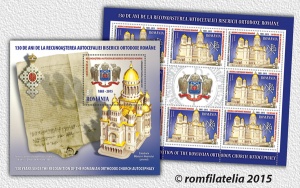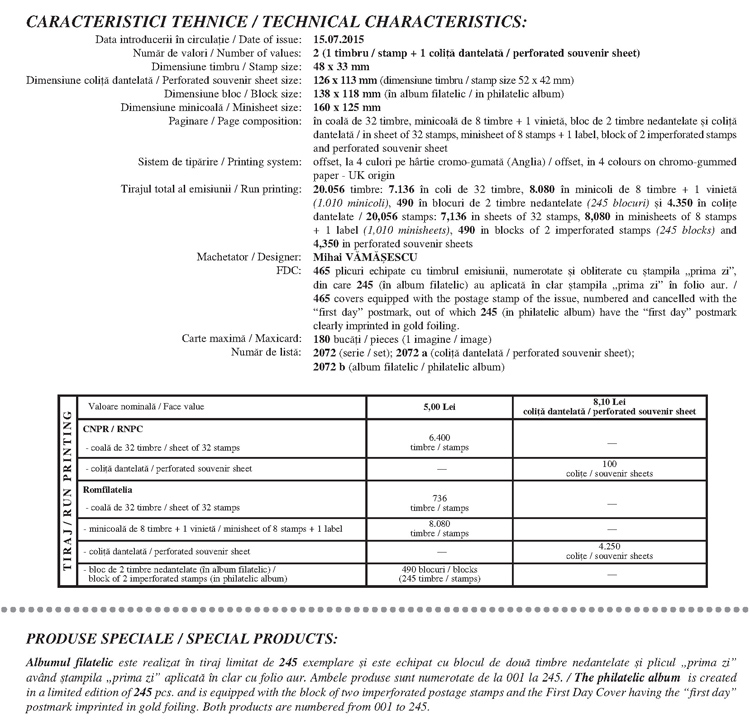 The second half of the 19th century was a period of adaptation for our countrys norms to the European modernism, in all areas, from administrative reform to the economic, political and cultural, but also religious reform.
The second half of the 19th century was a period of adaptation for our countrys norms to the European modernism, in all areas, from administrative reform to the economic, political and cultural, but also religious reform.
The reforms initiated by Ruler Alexandru Ioan Cuza and continued by King Carol I in turn, made it so that at the 19th and 20th centuries the Kingdom of Romania would become a modern state based on European principles.
The union of Wallachia with Moldavia on January 24th, 1859, the proclamation of State Independence on May 9th, 1877, and the proclamation of the Kingdom of Romania in 1881 were the prerequisites for the recognition of the Autocephaly for the Orthodox Church belonging to the young Romanian state.
Important steps have been made for this achievement in 1864, through the Constitutive Decree to set up a central synodal authority, in 1866, through the adoption of the Constitution and in 1872, through the development of the Constitutive Law for the election of metropolitans and diocesan bishops, as well as the founding of the Holy Synod of the Autocephalous Romanian Orthodox Church.
Repeatedly requested, the autocephaly was granted on April 25th, 1885, by the issue, in Constantinople, of the Synodal Tomos for the recognition of the Autocephaly of the Romanian Orthodox Church, signed by the Ecumenical Patriarch Joachim IV (1884-1886) together with the other metropolitans.
By attaining this status, the Romanian Orthodox Church wholly obtained the right to self-management, administrative-jurisdictional independence of any other autocephalous Orthodox Churches, remaining equal in rights and interdependence from a dogmatic, canonical and liturgical standpoint.
After the First World War, Romania recovered its historical provinces (Bessarabia, Bukovina and Transylvania), which hitherto were under foreign rule, thusly forming the Great Romania (December 1st, 1918). Spontaneously and naturally, the Romanian Orthodox people in those provinces united themselves with the Romanian Orthodox Church, resulting in the first Romanian Orthodox unification in history. Through this process of unification, the prestige of the Romanian Orthodox Church has skyrocketed in the bosom of Orthodoxy and its relations with other Christian Churches in the world.
As a natural consequence of this evolution, also came the idea of lifting the Romanian Orthodox Church to the rank of Patriarchate, which immediately found a wide support across the whole Romanian society. Thus, on December 7th, 1924, Nicolae Iorga published an article entitled The need to establish a patriarchy in which he would argue the Churchs historic right to be raised to the rank of Patriarchate. To give voice to this initiative, in the last days of 1924, the Metropolitan of Moldavia and Suceava, Pimen Georgescu (1909-1934), made the official proposal that the Metropolitan Church of Wallachia with the Metropolitan seat in Bucharest, be raised to the rank of Patriarchate; and the Wallachian Metropolitan, as the Primate of Romania, who by right is also the president of our Holy Synod, bear the title of Patriarch of the National Romanian Orthodox Church with his residence in Bucharest. Along with Metropolitan Pimen, this proposal was signed by: Nectarie, Metropolitan of Bukovina, Gurie, Archbishop of Bessarabia, Lucian, Bishop of Roman, Roman, Bishop of Oradea Mare, Nicolae, Bishop of Cluj, and Ilarie, Bishop of Constanta.
This proposal was submitted to the Holy Synod of the Romanian Orthodox Church to be analyzed in its autumn session of 1924. Postponed to December 4th, 1924, this session resumed work only on February 4th, 1925. To this historic meeting of the Holy Synod was also invited the Minister of Religious Affairs, Alexandru Lepadatu, who, on behalf of the Romanian Government, read a memorable exposé. After the true advocacy of the Minister of Religious Affairs, the Bishop of Ramnic, Vartolomeu Stanescu (1921-1938) read the Foundational Act of the Romanian Patriarchate, which synthesized all the elements necessary for the raising of the Romanian Orthodox Church to the rank of Patriarchate. At the end of the gathering on the day of February 4th, 1925, following the explanations and discussions in the plenary session, the Holy Synod unanimously and enthusiastically decided to establish the Romanian Patriarchate. In the same judgment was specified that His Eminence the Metropolitan Archbishop of Wallachia, Miron Cristea (1918-1939), was elevated to the rank of Patriarch of the Romanian Orthodox Church.
After taking this historic decision, the first patriarch of the Romanian Orthodox Church, Miron Cristea, gave a speech in which, having stated that the legal and competent ecclesiastical factor has raised our Church to the rank of Patriarchate, he tried to trace a brief work program including four segments. The first was to send as many young theologians to study in all the great centers of Western and Eastern culture to help raise the prestige of our Church. The second referred to the Romanian higher theological education, especially to the Faculty of Orthodox Theology in Bucharest, which had to be reorganized to become an Institute of thorough Orthodox theological culture, not only for our own necessities, but to attract the youth from all Orthodoxy. The third point of the program referred to the establishment of an Academy of church music. The last point emphasized the need to build a great cathedral for the salvation of the people, as an outward sign of the Patriarchate.
The idea of building a new cathedral in Bucharest, to represent both a symbol for the countrys capital and for the Church of the overwhelming majority of Romanians, was not a novelty, because the idea had been launched after the conquest of state independence, in 1878, and was reiterated after the achievement of the Autocephaly of the Romanian Orthodox Church, in 1885, and with more insistence after the Great Union of 1918, by the first Patriarch Miron Cristea.
For years on end, the problems regarding the start of the erection works on the cathedral were directly conditioned by its location, as well as the very high costs involved in developing the building.
After the First World War and the reunification of the country since 1918, the talks regarding the placement and construction of the future cathedral were resumed. The variants and solutions proposed were not finalized, due to the economic crisis at the end of the third decade of the 20th century, the outbreak of the Second World War and the 45 years of communism.
Thusly, the Romanian Orthodox Church, although recognized as autocephalous since 1885 and elevated to the rank of Patriarchate in 1925, until today has no patriarchal cathedral like all other sister Orthodox Churches, as a symbol of its unity and authority as a church, but also as an expression of the prestige it enjoys in Orthodoxy and the Christian world.
Following several placement versions, it was decided in 2011 to start the works on the construction of The Cathedral for the Salvation of the People, on the land found on the Arsenal Hill in Bucharest, one of the sites proposed since the late 19th century.
The concept of the new Cathedral for the Salvation of the People has a double meaning: the first concerns the compliance of the site with the plan, representing the liturgical, missionary nature, and the second one is undoubtedly the dominant component of the whole: a cathedral of the Romanian Nation.
The Cathedral for the Salvation of the Romanian People will cover 38,000 m2, will be 120 m long, 70 m wide and 120 m high, while inside, approximately 5,000 faithful would be able to take part in the church service.
The Cathedral will take on two patrons: Ascension Day (Romanias Remembrance Day) and St. Andrew (Protector of Romania).
With the erection of this monument, a symbol of Orthodoxy in Romania, the Romanians century old dream, to have a great Cathedral dedicated to those who gave their lives for this nation and to him who Christianized the Romanian people two thousand years ago, will be accomplished.
His Sanctity Patriarch Daniel emphasizes the purpose and message of a place of worship from a spiritual standpoint, stating that: in theological terms, we call it the mystagogy of a sacred space, which is transmitted as a sacrament, as a mystery of the edifices faith. Both the architecture and the painting of the Orthodox churches are the word built into symbol, and the symbol is a permanent word, a continuous transmission of the Gospels message. Therefore, we do not want to build something without symbolic significance. We do not oppose spirit and matter, but we make from matter an epiphany of the spirit.
Every year, on July 15th, Romanian Postage Stamp Day is celebrated, and this year, Romfilatelia addresses the theme 130 years since the Recognition of the Romanian Orthodox Church Autocephaly.
The stamp and souvenir sheet of the issue reproduce the images of the Peoples Salvation Cathedral project, the Tomos of recognition of the Romanian Orthodox Church Autocephaly (1885), along with elements of identity and thematic symbolism (the Patriarchate logo, the Patriarchal Cross).
We thank His Sanctity Daniel, the Patriarch of the Romanian Orthodox Church and the Romanian Patriarchate for the support in achieving this postage stamp issue.
Issue date: 2015-07-14



